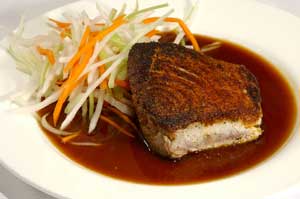Tuna
 |
|
Tuna is a healthy choice, whether canned, served raw, or cooked. Blackened and grilled, tuna can be as meaty as a beef steak. |
Tuna is an oily-fleshed game fish in the same family as marlin, mackerel, and swordfish. It is loaded with “hearty-healthy” omega-3 fatty acids. Some species are very large, weighing more than 1,500 pounds, while others are in the 6-15 pound range.
Varieties
Albacore (long-fin) – Also called “white meat tuna” and “chicken of the sea” due to its light-colored flesh and mild taste. Some canned tuna is of this variety, but it is usually more expensive.
Skipjack – The majority of canned tuna is produced from this small fish.
Bluefin and Southern Bluefin – Bluefin (the largest commercial tuna species) produces a superior meat used in Japanese sashimi restaurants. Very flavorful and expensive. Southern Bluefin is commonly served as part of a sushi meal.
Yellowfin – Sold as fresh and canned. This species has pale pink flesh and medium flavor.
Bigeye – Major market is for Japanese sashimi. Also known, along with yellowfin, by the Hawaiian name “ahi.”
Longtail (tongol) – Usually marketed as a “light” tuna.
Tuna is available whole, or cut into steaks, fillets, and loins.
Canned tuna has many practical uses, but does not compare in taste to fresh or frozen varieties.
Buying Tips
When shopping for whole tuna look at the eyes: they should be alert, not dulled. Skin should look moist and scales will be compact. Hold steaks up to the light and shift; older meat will display a rainbow.
Fresh tuna is graded as either “sashimi” (for raw dishes) or “grill/fry” (for cooking). Sashimi grade fish must be frozen to kill parasites before it can be sold.
Packaged fish can still be tested for freshness. The surface should bounce back when pressed.
When buying any fresh fish, make it your last stop. If possible, carry a cooler and keep tuna on ice.
Shop at reputable markets. The quality of fish is directly related to how it was caught and then treated during transport. A knowledgeable fish merchant will buy only the best.
Storage Tips
Refrigerate for no longer than two days. Place on a rack over an ice-filled pan and cover.
Canned tuna has a shelf life (unopened) of at least two years. Once opened, remove from original container and refrigerate for 3-4 days.
Tuna can be frozen for about four months if wrapped well.
Usage Tips
Tuna takes surprisingly little time to cook. A thin fillet may require only two minutes per side on a hot grill or in a skillet. However, the general rule of thumb is about 8 minutes for every inch of thickness. Overcooking causes loss of flavor and dries the fish, making it hard and unpalatable.
While cooking, use the punch and bounce-back technique. Flesh that does not respond is overdone. You may need to cut into the meat to judge color.
Tuna can be smoked, dried, blackened, grilled, sautéed, baked, steamed, and roasted. It's also de





